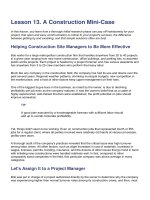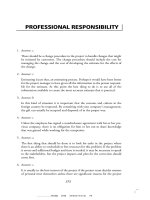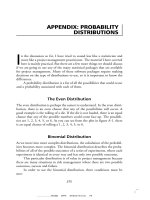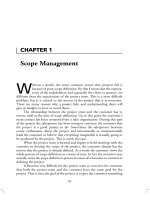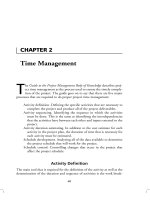Organizational project management
Bạn đang xem bản rút gọn của tài liệu. Xem và tải ngay bản đầy đủ của tài liệu tại đây (1.61 MB, 135 trang )
TheStandardfor
ORGANIZATIONALPROJECT
MANAGEMENT(OPM)
LibraryofCongressCataloging-in-PublicationData
Title:Thestandardfororganizationalprojectmanagement(OPM).
Description:NewtownSquare,PA:ProjectManagementInstitute,2018.|Includesbibliographical
referencesandindex.
Identifiers:LCCN2018018297(print)|LCCN2018020060(ebook)|ISBN9781628255546(ePUB)|ISBN
9781628255553(kindle)|ISBN9781628255560(WebPDF)|ISBN9781628252002(paperback)
Subjects:LCSH:Projectmanagement.|Projectmanagement–Standards.|BISAC:BUSINESS&
ECONOMICS/ProjectManagement.
Classification:LCCHD69.P75(ebook)|LCCHD69.P75S732018(print)|DDC658.4/04–dc23
LCrecordavailableat />ISBN:978-1-62825-200-2
Publishedby:
ProjectManagementInstitute,Inc.
14CampusBoulevard
NewtownSquare,Pennsylvania19073-3299USA
Phone+1610-356-4600
Fax:+1610-356-4647
Email:
Website:www.PMI.org
©2018ProjectManagementInstitute,Inc.Allrightsreserved
OurcopyrightcontentisprotectedbyU.S.intellectualpropertylawthatisrecognizedbymostcountries.To
republishorreproduceourcontent,youmustobtainourpermission.Pleasegoto
fordetails.
PMI,thePMIlogo,PMBOK,OPM3,PMP,CAPM,PgMP,PfMP,PMI-RMP,PMI-SP,PMI-ACP,PMIPBA,PROJECTMANAGEMENTJOURNAL,PMNETWORK,PMITODAY,PULSEOFTHE
PROFESSIONandthesloganMAKINGPROJECTMANAGEMENTINDISPENSABLEFOR
BUSINESSRESULTS.areallmarksofProjectManagementInstitute,Inc.ForacomprehensivelistofPMI
trademarks,contactthePMILegalDepartment.Allothertrademarks,servicemarks,tradenames,trade
dress,productnamesandlogosappearinghereinarethepropertyoftheirrespectiveowners.Anyrightsnot
expresslygrantedhereinarereserved.
ToplaceaTradeOrderorforpricinginformation,pleasecontactIndependentPublishersGroup:
IndependentPublishersGroup
OrderDepartment
814NorthFranklinStreet
Chicago,IL60610USA
Phone:+1800-888-4741
Fax:+1312-337-5985
Email:(Forordersonly)
Forallotherinquiries,pleasecontactthePMIBookServiceCenter.
PMIBookServiceCenter
P.O.Box932683,Atlanta,GA31193-2683USA
Phone:1-866-276-4764(withintheU.S.orCanada)or+1-770-280-4129(globally)
Fax:+1-770-280-4113
Email:
PrintedintheUnitedStatesofAmerica.Nopartofthisworkmaybereproducedortransmittedinanyform
orbyanymeans,electronic,manual,photocopying,recording,orbyanyinformationstorageandretrieval
system,withoutpriorwrittenpermissionofthepublisher.
ThepaperusedinthisbookcomplieswiththePermanentPaperStandardissuedbytheNational
InformationStandardsOrganization(Z39.48—1984).
10987654321
NOTICE
The Project Management Institute, Inc. (PMI) standards and guideline
publications, of which the document contained herein is one, are developed
through a voluntary consensus standards development process. This process
brings together volunteers and/or seeks out the views of persons who have an
interest in the topic covered by this publication. While PMI administers the
process and establishes rules to promote fairness in the development of
consensus, it does not write the document and it does not independently test,
evaluate, or verify the accuracy or completeness of any information or the
soundness of any judgments contained in its standards and guideline
publications.
PMIdisclaimsliabilityforanypersonalinjury,propertyorotherdamagesof
anynaturewhatsoever,whetherspecial,indirect,consequentialorcompensatory,
directly or indirectly resulting from the publication, use of application, or
reliance on this document. PMI disclaims and makes no guaranty or warranty,
expressed or implied, as to the accuracy or completeness of any information
publishedherein, anddisclaimsandmakesnowarrantythattheinformationin
thisdocumentwillfulfillanyofyourparticularpurposesorneeds.PMIdoesnot
undertake to guarantee the performance of any individual manufacturer or
seller'sproductsorservicesbyvirtueofthisstandardorguide.
Inpublishingandmakingthisdocumentavailable,PMIisnotundertakingto
renderprofessionalorotherservicesfororonbehalfofanypersonorentity,nor
is PMI undertaking to perform any duty owed by any person or entity to
someone else. Anyone using this document should rely on his or her own
independent judgment or, as appropriate, seek the advice of a competent
professional in determining the exercise of reasonable care in any given
circumstances. Information and other standards on the topic covered by this
publication may be available from other sources, which the user may wish to
consultforadditionalviewsorinformationnotcoveredbythispublication.
PMIhasnopower,nordoesitundertaketopoliceorenforcecompliancewith
the contents of this document. PMI does not certify, test, or inspect products,
designs,orinstallationsforsafetyorhealthpurposes.Anycertificationorother
statement of compliance with any health or safety-related information in this
documentshallnotbeattributabletoPMIandissolelytheresponsibilityofthe
certifierormakerofthestatement.
TABLEOFCONTENTS
1.INTRODUCTION
1.1IntendedAudience
1.2Overview
1.3OPMApproach
1.3.1OPMPrinciples
1.3.2OrganizationalStructure
1.3.3OPMFramework
1.3.4OrganizationalBenefitsofOPM
1.4HowtoUsethisStandard
1.5RelationshipsAmongPortfolio,Program,andProject
ManagementandOPM
1.6OrganizationalStrategy
1.6.1OPMMaturityModels
1.6.2PMOandOPM
1.6.3EnterpriseProjectManagementOffice(EPMO)
1.7OPMStakeholders
2.FOUNDATIONALCONCEPTS
2.1Introduction
2.2InvestinginOPMandAddingValue
2.3BusinessValue
2.4OPMBusinessCase
2.4.1OPMSponsorship
2.4.2TheValueProposition
2.4.3BenefitsSustainment
2.4.4ElementsoftheOPMBusinessCase
2.4.5EstablishingaBaselinefortheBusinessCase
3.INTRODUCTIONTOTHEOPMFRAMEWORK
3.1Introduction
3.2OPMMethodologies
3.3KnowledgeManagement
3.4TalentManagement
3.5OPMGovernance
4.ELEMENTSOFANOPMFRAMEWORKWITHINTHE
ORGANIZATION
4.1Introduction
4.2OPMMethodologies
4.2.1EstablishingOPMMethodologies
4.2.2TailoringandApplyingOPMMethodologies
4.3KnowledgeManagement
4.3.1KnowledgeManagementForOPM
4.3.2OrganizationalObjectives
4.3.3KnowledgeManagementLifeCycle
4.3.3.1CreateKnowledgeContent
4.3.3.2ShareKnowledgeContent
4.3.3.3StoreKnowledgeContent
4.3.3.4UseKnowledgeContent
4.3.3.5UpdateKnowledgeContent
4.3.4Best-In-ClassLearningEnvironment
4.3.5MeasuringImpactofKnowledgeManagement
4.4TalentManagement
4.4.1Assessment(FormalorSelf-Assessment)
4.4.2CompetencyDevelopmentPlans
4.4.2.1ExperientialLearning
4.4.2.2FormalLearning
4.4.2.3InformalLearning
4.4.3JobRolesandDescriptions
4.5OPMGovernance
4.5.1GovernanceEntities
5.IMPLEMENTATIONOFOPM
5.1Introduction
5.2DefiningtheOPMInitiative
5.3DefineRolesandtheProgramOrganization
5.3.1OPMInitiatingCommittee
5.3.2OPMImplementationProgramSponsor
5.3.3ProjectManagementOffice
5.3.4OPMImplementationProgramManager
5.3.5OPMIntegratorandOrganizationalChangeTeam
5.3.6AdditionalRoles
5.4DevelopBusinessCase
5.5OPMMaturity
5.6DefinetheRoleofOPMMaturityModelsintheInitiative
5.7ProcessManagement
5.8EstablishOPMPerformanceMetricsandKey
PerformanceIndicators
5.9PlanningConsiderationsfortheOPMInitiative
6.ONGOINGOPMMANAGEMENTANDMONITORING
6.1Introduction
6.2EnsuringOPMBenefitsRealizationandSustainment
6.3Long-TermMonitoringandAnalysisofOPM
6.4PlanningandImplementingMethodologyUpdates
6.5LaunchingMethodologyUpdates
APPENDIXX1
CONTRIBUTORSANDREVIEWERSOFTHESTANDARD
FORORGANIZATIONALPROJECTMANAGEMENT
APPENDIXX2
ORGANIZATIONALCONSIDERATIONSFOROPM
IMPLEMENTATION
APPENDIXX3
RECOMMENDEDSURVEYQUESTIONSREGARDING
IMPLEMENTATIONOFOPMINITIATIVES
APPENDIXX4
HOWTODEVELOPATAILOREDORGANIZATIONAL
PROJECTMANAGEMENT(OPM)METHODOLOGY
APPENDIXX5
ORGANIZATIONALENABLERSFOROPM
REFERENCES
GLOSSARY
LISTOFTABLESANDFIGURES
Figure1- OrganizationalProjectManagement
1.
Figure1- OPMFramework
2.
Figure1- Portfolio,Program,andProjectManagement
3.
Interactions
Figure1- PotentialOPMBenefitsforOrganizations
4.
Figure1- GeneralFlowandIntendedOutcomesofUsingThis
5.
Standard
Figure3- CriticalElementsofOPMFramework
1.
Figure4- KnowledgeManagementLifeCycle
1.
Figure4- GovernanceHierarchy
2.
Figure5- ExampleOPMImplementationProgram
1.
Organization,RolesandRelationships
Figure5- ExampleofOPMMaturityModelInteractionina
2.
ProjectOrganization
Figure5- TheRelationshipBetweenCompetencyDevelopment,
3.
ToolsandTechnology,andProcesses
Figure5- ProjectPerformanceMeasurementBaseline(PMB)
4.
ComparisonsatSpecificInstancesThroughoutthe
ProjectLifeCycle
Figure6- OPMMethodologyMaintenanceProcess—Long-Term
1.
Model
Figure
X2-1.
PriorityAssessment—WhatisImportanttothe
Organization
Figure
X4-1.
MethodologyTailoringProcess
Table1-1. InfluencesofOrganizationalStructuresonProjects
Table1-2. ComparativeOverviewofPortfolio,Program,and
ProjectManagement
PREFACE
AGuidetotheProjectManagementBodyofKnowledge(PMBOK®Guide)–
SixthEditionandotherPMIstandardsprovideguidanceonthemanagementof
portfolios, programs, and projects in order to achieve successful outcomes for
those activities. In an organizational environment, portfolios, programs, and
projects should be managed in alignment with organizational business strategy
andobjectivesinamannerthatwillprovidethemostbenefittotheorganization.
Organizational project management (OPM) is the framework used to align
project, program, and portfolio management practices with organizational
strategy and objectives, and customizing or fitting these practices within the
organization's context,situation,orstructure.This StandardforOrganizational
Project Management (OPM) provides guidance to organizational management,
PMOstaff,andpractitionersonthesetopics.
This Standard for Organizational Project Management (OPM) is a
replacementforthepreviousImplementingOrganizationalProjectManagement:
A Practice Guide, which was published by PMI in 2014, and expands on the
contentfoundinthatpracticeguide.
Thechangeintitlefrompracticeguidetostandardreflectsachangefromthe
procedural-based how guidance found in PMI practice guides to a greater
emphasis on the principles-based why of practicing project management in an
organizationalsetting.Procedural-basedguidanceofthepracticeguidehasbeen
moved into the appendices of this standard. PMI standards go through a more
thorough, rigorous approval process than practice guides, which reflects the
maturityofthetopic.
This standard is not a replacement for the Organizational Project
Management Maturity Model (OPM3®) standard, which continues to be
published by PMI. The two standards can be used in conjunction with one
another. This standard provides guidance to organizations as they implement
projectmanagementpracticesattheorganizationallevelanddevelopcapabilities
and maturity in that practice. The OPM3® standard, as well as other available
maturitymodels,isusedasatooltomeasurethosecapabilities,identifyareasfor
improvement,andenhancetheleveloforganizationalmaturitywithregardtothe
practiceofprojectmanagement.
1
INTRODUCTION
This standard provides guidelines for creating an organizational project
management (OPM) framework. OPM entails adapting and aligning practices
and processes to provide optimum support for achieving the organization's
strategic objectives by means of portfolio, program, and project management.
Thisstandardisparticularlyusefulfororganizationsthatdonothaveaunified
project management approach and those in the process of improving or
sustainingtheircurrentprojectmanagementframework.
OPMadvancesorganizationalcapabilitybydevelopingandlinkingportfolio,
program, and project management principles and practices with organizational
enablers and organizational processes to support strategic objectives.
Organizationalenablersarestructural,cultural,technological,orhuman-resource
practicesthattheperformingorganizationcanusetoachievestrategicobjectives.
1.1INTENDEDAUDIENCE
This standard is intended for practitioners who are involved in portfolio,
program,andprojectmanagement.Thesepractitionersmayincludebutarenot
limitedto:
Executives with responsibility for strategy delivery in for-profit,
nonprofitorgovernmentdivisions,andorganizationalunits;
Executives or managers involved in the support of OPM, such as
those responsible for portfolio/program/project management offices
(PMOs)orcentersofexcellence(COEs);
Anystakeholderinvolvedintheleadership,management,oroversight
ofportfolios,programs,and/orprojects;
Any stakeholder responsible for oversight OPM governance or
developingOPM-relatedpolicies;
Portfolio, program, and project managers in leadership and liaison
positions,suchasfunctionalandservicedeliverymanagers,whoare
responsibleforOPM-relatedorganizationalcapabilities;
Process and organizational change professionals (including quality
andcapabilitymanagementmaturityimprovementprofessionals)who
areinvolvedinthedesignandimplementationofportfolio,program,
and/orprojectperformanceimprovementinitiatives;
Other management staff who may be responsible for oversight of
portfolios,programs,and/orprojects;
Membersofstrategicportfolios,programs,PMOs,and/orCOEs;or
Functionalmanagers,includingthosewhomanageportfolio,program,
andprojectmanagementprofessionals.
1.2OVERVIEW
This standard provides guidelines to assist organizations in identifying,
assessing, and applying recognized principles, concepts, methods, and best
practices in order to establish and sustain OPM capability. It is intended to
enable organizations to better structure the management of their portfolios,
programs,andprojectsinordertoachievestrategicobjectives.Thisstandardis
organizedasfollows:
Section 1—Purpose of the Standard for Organizational Project
Management.Thissectionincludesanoverviewofthestandardand
describes OPM principles, key stakeholders, and essential
considerationsforimplementation.Additionally,thissectiondescribes
the relevance of OPM and its framework, the intended audience for
thestandard,andrecommendationsonhowtoapplythisstandard.
Section 2—Foundational Concepts. This section describes
foundationalOPM-essentialconcepts andfactors thatcontribute toa
successfulOPMimplementation.ItdiscusseswhatOPMisandhowit
supportstheorganization.
Section 3—Introduction to the OPM Framework. The OPM
frameworkdescribestheelementsneededtoprovideongoingsupport
forOPMaswellastherequirementstosetupanOPMmethodology
in any organization. This section provides a description of the
framework in terms of core elements including methodology,
knowledge management, and talent management to support the
implementationofanorganizationalstrategy.
Section 4—Elements of an OPM Framework within the
Organization. This section describes the identification of an OPM
framework, including the tailoring of key OPM elements such as
methodology, knowledge management, talent management, and
governance.
Section 5—Implementation of OPM. This section describes
considerations that typically are encountered in an OPM
implementation program, such as future operating state design,
program organization, business case, and areas of benefits
identification. Examples of OPM maturity models are presented to
allowunderstandingoftheirroleinplanningandcontrollingtheOPM
initiative from a capability identification and development
perspective.
Section 6—Ongoing OPM Management and Monitoring. This
section describes how the organization can ensure that an OPM
initiative successfully delivers the planned benefits and that the
benefits will be sustained upon completion of the implementation
program. It also discusses how long-term monitoring of the
implementedOPMsystemisperformedtoensurethatitcontinuously
improvesthesystemandrealizationofbenefits.
Theappendixesincludedareasfollows:
Appendix X1. Contributors and Reviewers of the Standard for
OrganizationalProjectManagement
Appendix X2.
Implementation
Organizational
Considerations
for
OPM
Appendix X3. Recommended Survey Questions Regarding
ImplementationofOPMInitiatives
Appendix X4. How to Develop a Tailored Organizational Project
ManagementMethodology
AppendixX5.OrganizationalEnablersforOPM
1.3OPMAPPROACH
OPM is a framework in which portfolio, program, and project management
are integrated with organizational enablers in order to achieve strategic
objectives. OPM supports the appropriate balance of knowledge, processes,
people, and supportive tools across all functional areas of the organization to
provide guidance for its portfolio, program, and project management efforts.
Figure 1-1 depicts a systematic OPM approach across all OPM domains that
encompassesthefollowing:
Strategy.Ahigh-levelplandesignedtoachievethemajorgoalsusing
internal and external resources from the organization in an effective
andefficientmanner.Strategicplanningistheprocessofformulating
andimplementingdecisionsaboutanorganization'sfuturedirection.
Portfoliovaluedecisions.Usedtoeffectivelyselecttheinitiativesin
the portfolio that will support the strategy of the organization to
achievetheestablishedmajorlong-termobjectives.
Programsandprojects.Usedforeffectiveandefficientexecutionof
initiatives aligned with strategies intended to deliver predictable
businessvalue.
Operations.Operationalizestheinitiativesandmeasuresthebusiness
valuethroughabenefitsrealizationprocess.
Portfolio review and adjustments. Aligns strategy and
organizationalresourcesthroughadisciplinedbusinessvaluedecision
processtoreflectinternalandexternalchangingconditions.
Business impact analysis. Analyzes the impact and value from the
programs and projects that were implemented and incorporates
businessresultsdataintotheportfolio.
Valueperformanceanalysis.Providesbusinessvaluerealizationdata
from business value fulfillment back to the strategy of the
organization.
Organizational environment. Represents the organizational
governance, policies, organizational culture and supporting practices
oftheorganizationthatarecreatedtosupportOPMandorganizational
strategydelivery.
Each OPM approach encompasses multiple processes that translate into
specificcapabilitiesthatanorganizationshouldpossessinordertoimproveits
maturity and better succeed with its strategy execution. Additionally, the
organization needs an environment with demonstrated OPM capabilities to
supportdeliveringitsstrategyandvalue.
Because OPM describes many capabilities, each organization needs to
determinewhichcapabilitiesarenecessarytorealizeitsstrategy.Forexample,a
bank in one country may not require the exact same capabilities as a bank in
another country or the exact same capabilities as a software development
organization.
OPM is based on performing portfolio, program, and project management,
coupledwithenablingbusinessprocessandimprovementpracticesconductedin
theappropriatemanner,toachieveconsistentresultsthatalignwiththestrategic
priorities.Theimplementationofbusinessorprocessimprovementpracticesthat
support a strategy execution framework does not ensure the achievement of
betterresults. Toachievebetterresults,strategyexecutionshould becombined
with the appropriate mix of skilled people using defined processes in order to
achievestrategicobjectives.
1.3.1OPMPRINCIPLES
Organizationsfacechallengesastheystrivetoimprove.Organizationsneedto
useresourceseffectivelytoefficientlyachievetheirobjectives.
OPMisintendedtoassistorganizationstodelivervalueandisbasedonthe
followingprinciples:
Alignment with organizational strategy. All portfolios, programs,
and projects should transparently and measurably support
organizationalstrategy.
Integration with organizational enablers. Successful alignment,
execution, and delivery of portfolios, programs, and projects are
predicatedontimelycooperationofalldirectlyorindirectlyinvolved
practices.
Consistency of execution and delivery. All authorized portfolios,
programs,andprojectsshouldbeexecutedanddeliveredconsistently
within governance and methodology parameters in an ethical and
professionalmanner.
Organizational integration. Successful alignment, execution, and
deliveryofportfolios,programs,andprojectsarepredicatedontimely
cooperation and collaboration of all organization's stakeholders in
additiontoexecutivesupport.
Value to the organization. Investing and working within the OPM
framework delivers products, services, results, or benefits that
outweighcoststooperateit.
Continuous development. Tracking and documenting employees’
competences, skills, knowledge, and experience acquired formally
andinformallyastheyperformtheirdailyactivities.
1.3.2ORGANIZATIONALSTRUCTURE
In many organizations, achieving strategic objectives are accomplished
through established processes and governance structures. Executives make
investmentdecisionsconsideringamixofprogramsandprojectsmostlikelyto
support the achievement of the organization's strategic objectives. These
decisionsarebasedontheorganization'sriskappetite,resourceconstraints,and
knowledgebase(i.e.,people,knowledge,andfunding).
While executives, managers, and project management practitioners seek
improved results through implemented strategies, organizations need to
understand the various project-based organizational models that accommodate
different situations. Organizational structures, which traditionally may be of
manytypes(e.g.,organic,functional,matrix,project-oriented,virtualorhybrid),
can affect resource availability and influence how projects are executed. The
organizational structure influences the environment in which the project will
function within the organization as described in Table 1-1. Various structures
shouldbeconsideredtoensureproperresourceallocationandproperapproaches
and policies to support the delivery of the proposed business plan value. The
implementationofOPMrequirescross-functionalprojectteams.Teammembers
should be available when the project starts, and in consideration of the
organizational structure, the functional manager should support the team
members’participationontheprojectteam.
Portfolio,program,andprojectmanagementrequiresdeliberateplanningand
action to create the optimal conditions for success. This entails implementing
strategy, leadership, goals, processes, skills, systems, issue resolution,
complexity navigation, risk mitigation, and structure to direct and exploit the
dynamic nature of project execution. However, when strategy moves from the
boardroomtooperations,theabilitytoconsistentlyandsuccessfullydeliverby
usingprojectmanagementissometimesoverlooked.
Regardless of the organization type—organic, functional, multidivisional,
matrix, or project-oriented, virtual or hybrid—the strategic alignment should
haveacross-functionaldynamic.Membersofallfunctionalareasshouldcomply
withtheprogramandprojectteamstomeettheendobjective.
Assuming the organization is not project oriented, the customary way of
workingwillchange:
Employeeswillworkonprojectsasatemporaryassignmentbutstill
reporttoafunctionalarea.
A new generation of project managers will evolve from business
functions.
Manyotherchangeswillbeexperienced.
These changes require organizations to adopt an integrated project approach
including structures such as a governance-oriented enterprise project
managementoffice(EPMO)(seeSections1.6.2and1.6.3formoreinformation).
Thesestructuresshouldenable organizationstopromotetheimplementationof
OPM. When adopted, an EPMO aims to ensure strategic alignment of the
portfolioinitiativestothestrategicobjectives.TheEPMOprovidesgovernance,
structure, process, and procedures to control operations and changes to
performanceobjectivesandbenefitsmanagement.
Anintegratedleadership,management,andsupportiveenvironmentiscritical
for the management of portfolios, programs, and projects, as are other
operationalandsupportfunctions,suchastechnicalsupportorcustomerservice.
The EPMO should tightly integrate its planning, execution, and monitoring
processeswiththemanagementoftheoperationalpartoftheorganization.This
will help to ensure the appropriate balance between program and project
activities and business operations, including optimal use of the organization's
resources.
Successfulorganizationsachievestrategicobjectiveswhen:
Portfolio, program, and project management practices are aligned to
thestrategy;
The organization provides executives with visibility and uses active
executivesponsorsonprojects;and
The organization uses methods to manage change effectively, hires
qualifiedprojectmanagers,anddeliversprojectsthatachievestrategic
objectives.
1.3.3OPMFRAMEWORK
TheOPMframeworksupportsbalanceandcoordinationbetweenprojectand
businessmanagementinsupportoforganizationalstrategy(seeFigure1-2).The
OPM framework needs to be visibly supported and properly communicated
across the organization to become a priority to both management and
practitionersinvolvedintheimplementationofOPM.
The OPM framework provides the basis for the implementation of OPM to
help the organization align resources to achieve its strategic objectives. It is
important to understand the relationships among portfolios, programs, and
projects in order to understand OPM. A portfolio refers to a collection of
projects,programs,subsidiaryportfolios,andoperationsmanagedasagroupto
achieve strategic objectives. Programs include related projects, subsidiary
programs, and program activities managed in a coordinated manner to obtain
benefitsnotavailablefrommanagingthemindividually.Individualprojectsthat
areeitherwithinoroutsideofaprogramarestillconsideredpartofaportfolio.
Although the projects or programs within a portfolio may not necessarily be
interdependentordirectlyrelated,theyarelinkedtotheorganization'sstrategic
planbymeansoftheorganization'sportfolioplan.
Figure1-3showshowtheportfolioislinkedtoorganizationalstrategyandthe
relationships among portfolios, programs, and projects, as well as between
programsandindividualprojects.
OPM as part of organizational planning includes the prioritization and
selection of programs and projects based on components relevant to the
organization'sstrategicplan.Criteriasuchasresourcesavailability,riskfactors,
line of business, expected benefits, types of projects, funding, market analysis,
anddirectionofshort-andlong-termvisionarecrucialinthealignmentofthe
portfolioanddeterminethefuturesuccessofprogramsandprojects.
The need for OPM emerged from increased project management knowledge
andpractices.TheemergenceofthePMOandEPMOanduseofbestpractices
andstandardshasenhancedtheunderstandingofthemanagementofprograms
and portfolios. The OPM framework provides flexibility to accommodate


